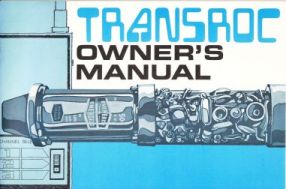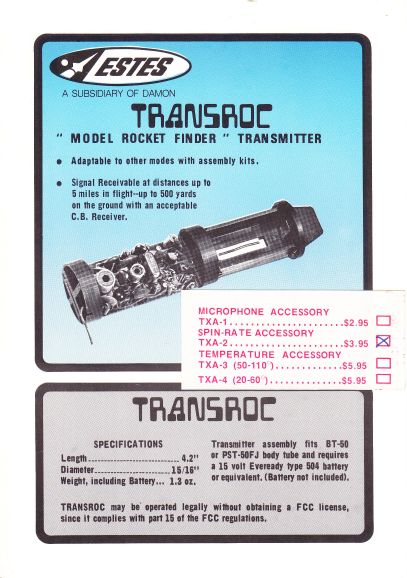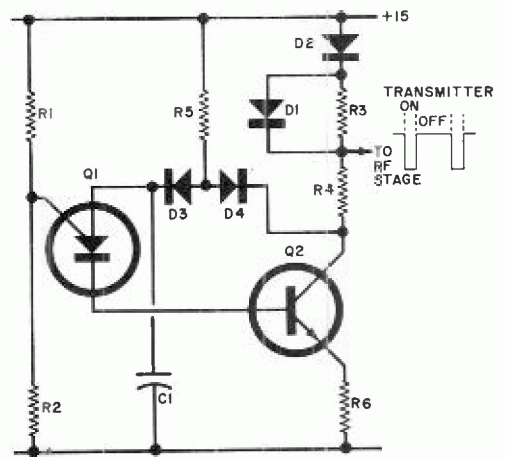
|
|

The TRANSROC is a miniature, multipurpose transmitter sold during the 1970s in kit and preassembled form by Estes Industries for use with model rockets. The TRANSROC has three basic modes of operation one of which, TM (telemetering), can be further broken down and expanded into several subdivisions.
Rocket Finder
Telemetering
Microphone
|
|
Note that some changes were made in the design of the TRANSROC after
the first 1,000 units had been manufactured. The changes which generated
the "B" configuration made an improvement in ease of construction
and made the PC board less subject to being damaged by excessive soldering
heat. These changes also made it unnecessary for a resistor to be selected
by the owner when installing his first TM kit. Although these circuit
changes were minor, considerable change to the PC board layout was
required in order to accomodate them.
The "A" and "B" configurations are identical in operating characteristics and specifications. |
|
From Model Rocket News, June 1971 (Volume 11 Number 2):
TRANSROC |

Owner's Manual Original Model ("A" configuration)
|

|
|
From the October 1971 issue of Model Rocketry (v4n1):
Flight Test: The Estes "TRANSROC"
|
|
|
The following article appeared in the May 1972 issue of Popular Electronics:
ESTES "TRANSROC" RADIO CONTROLLED TRANSMITTER

Recently we had the opportunity to build and test the "Transroc" model aircraft and rocket transmitter put out by Estes Industries. Since it was designed to be used in conjunction with a conventional Citizens Band receiver, we were surprised at the compact size of the six-transistor, crystal-controlled transmitter.
The Transroc is no simple little toy meant to be used by aspiring young scientists. In fact, the transmitter did things that surprised even old model rocketry veterans like us. When properly set up, the Transroc can provide any one of three different modes of operation: first, it is a "beeper" which transmits one beep per second on the CB band - a signal used to locate a downed model aircraft or rocket. Second, it can be used for telemetry by employing some form of signal-to-resistance sensor (photocell, etc.). Finally, used with a microphone, it becomes an under-100-mW AM CB phone rig.
Circuit Design. To give you an idea of the sophisticated circuit design used in the Transroc, the schematic diagram shows a portion of the modulator - in this configuration, a beeper. For the analysis, start at the collector of Q2 and assume that this transistor is cut off. In this state, the diode gate consisting of D3 and D4 is switched on by the current through D2, R3 and R4. The junction of D3 and D4 is supplied with charging current through R5. This current builds up a voltage across C1 and is also supplied to transistor switch Q1 as one of its inputs. The other input to Q1 is via voltage divider R1/R2.

When the anode voltage of Q1 reaches the level of its gate voltage, Q1 conducts and C1 begins to discharge through the transistor, the base-emitter junction of Q2, and current-limiting resistor R6. The flow of current turns on Q2, and the voltage drop at the transistor's collector cuts off the D3/D4 gate. This stops the charging current to C1. After a time period approximately one-half as long as was required to charge C1, Q1 automatically resets to the nonconducting state cutting off Q2 and allowing the process to repeat as long as power is applied.
The Transroc was tested (in the beeper mode) in a working model aircraft using a conventional CB receiver with a loop antenna. There was no trouble locating the downed aircraft almost a mile away. We listened to similar units operating in the telemetry mode and were surprised at the excellent signals.
Price of the Transroc is $21.95 assembled or $14.95 in kit form.
Last updated March 4, 2024